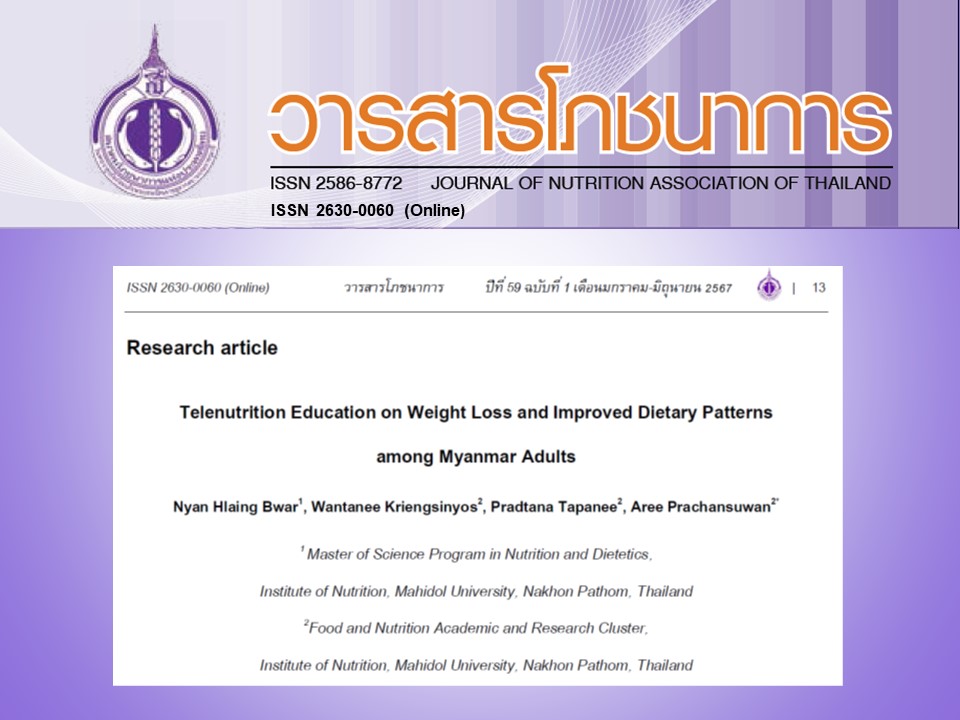Telenutrition Education on Weight Loss and Improved Dietary Patterns among Myanmar Adults
Keywords:
Obesity, Lifestyle Intervention, Telenutrition, Group Lifestyle BalanceAbstract
This study examined the effectiveness of a telenutrition education program based on the proven Group Lifestyle Balance (GLB) protocol in promoting weight management and improving dietary patterns among overweight and obese adults in Myanmar. A pretest-posttest study was conducted among a single group of participants who had no underlying conditions. Twelve weekly nutrition sessions were held in a group setting using a telenutrition platform. Data on body weight, dietary intake, and physical activity level were collected at the end of the first and eleventh weeks. Out of 28 participants, five dropped out due to health and occupational issues. Results showed that participants achieved an average of 6.7% reduction in body weight. Regarding the diversity of food group choices, a significant improvement in the Food Group Diversity Score (FGDS) from 3.62 (SD, 0.98) to 5.18 (SD, 0.97) was evident. Moreover, the average duration of physical activity per week increased from 147.17 minutes (SD, 134.79) to 331.90 minutes (SD, 341.32). While there was no significant increase in fruit or vegetable portion intakes, participants tended to consume wider varieties of these foods according to the FGDS score. In addition, though not statistically significant, a mean reduction of 3.58 g in saturated fat intake was found. Consequently, implementing a telenutrition platform to deliver the GLB program shows potential as an effective approach for assisting overweight and obese adults in Myanmar in achieving weight loss within a feasible timeframe.
References
Jnr BA. Use of telemedicine and virtual care for remote treatment in response to COVID-19 pandemic. J Med Syst. 2020;44(7):132.
Jordan RE, Adab P, Cheng K. Covid-19: risk factors for severe disease and death. BMJ. 2020;26:368.
Zhou Y, Chi J, Lv W, Wang Y. Obesity and diabetes as high‐risk factors for severe coronavirus disease 2019 (Covid‐19). Diabetes Metabol Res Rev. 2021;37(2):e3377.
Country Nutrition Profiles, Myanmar [Internet]. Global Nutrition Report; c2023 [retrieved accessed May 2023]. Available from: https://globalnutritionreport.org/resources/nutrition-profiles/asia/south-eastern-asia/myanmar/
Yarnall KS, Pollak KI, Østbye T, Krause KM, Michener JL. Primary care: is there enough time for prevention?. Am J Publ Health. 2003;93(4):635-641.
Telehealth for Dietetic Practitioners [Internet]. eatrightPRO.org, Academy of Nutrition and Dietetics; c2021 [retrieved May 2023]. Available from: https://www.eatrightpro.org/practice/practice-resources/telehealth#quickGuide
Ventura Marra M, Lilly CL, Nelson KR, et al. A pilot randomized controlled trial of a telenutrition weight loss intervention in middle-aged and older men with multiple risk factors for cardiovascular disease. Nutrients. 2019;11(2):229.
Saintila J, Salinas Arias SA, Calizaya-Milla YE, et al. Effectiveness of a Program Based on Telehealth in Nutritional Knowledge and Body Mass Index in Peruvian University Teachers. J Prim Care Community Health. 2021;12.
Allen JK, Stephens J, Patel A. Technology-assisted weight management interventions: systematic review of clinical trials. Telemed J e Health. 2014;20(12):1103-1120.
Zomer E, Gurusamy K, Leach R, et al. Interventions that cause weight loss and the impact on cardiovascular risk factors: a systematic review and meta‐analysis. Obes Rev. 2016;17(10):1001-1011.
Kramer MK, Kriska AM, Venditti EM, et al. Translating the Diabetes Prevention Program: a comprehensive model for prevention training and program delivery. Am J Prev Med. 2009;37(6):505-511.
Chesla CA, Chun KM, Kwong Y, et al. Cultural adaptation of the group lifestyle balance program for Chinese Americans. Diabetes Educat. 2016;42(6):686-696.
Kramer MK, McWilliams JR, Chen HY, et al. A community-based diabetes prevention program: evaluation of the group lifestyle balance program delivered by diabetes educators. Diabetes Educat. 2011;37(5):659-668.
Diabetes Prevention Program Group Lifestyle Balance™ Materials [Internet]. Diabetes Prevention Support Center, University of Pittsburgh; c2017 [retrieved May 2023]. Available from: https://www.diabetesprevention.pitt.edu/group-lifestyle-balance-materials/
Group Instructor Guides Sessions [Internet]. Diabetes Prevention Support Center, University of Pittsburgh; c2015 [retrieved May 2023]. Available from: https://www.norc.org/PDFs/CMS-OMH/CABLE/Group-Instructor-Guides-Sessions_English.pdf
GLB Keeping Track Booklet [Internet]. Diabetes Prevention Support Center, University of Pittsburgh; c2017 [retrieved May 2023]. Available from: https://www.diabetesprevention.pitt.edu/download-glb-keeping-track-booklet/
อาริสา กีรติจำเริญ คู่มือการใช้โปรแกรม INMUCAL-Nutrients V.4.0 ฉบับปรับปรุง [software]. Thailand: Institute of Nutrition, Mahidol University; 2019 [retrieved 2023 May]. Available from: https://repository.li.mahidol.ac.th/handle/123456789/53125
Longvah T, Anantan I, Bhaskarachary K, et al. Indian food composition tables. Hyderabad: National Institute of Nutrition, Indian Council of Medical Research; 2017 May.
Diet Quality Questionnaire Indicator Guide [Internet]. Global Diet Quality Project; c2023 [retrieved May 2023]. Available from: https://drive.google.com/file/d/1eplRm9i5_109-a5Ac1Lqj-lUI3VgVIFx/view
Kramer MK, Kriska AM, Venditti EM, et al. A novel approach to diabetes prevention: evaluation of the Group Lifestyle Balance program delivered via DVD. Diabetes Res Clin Pract. 2010;90(3):e60-e63.
Amundson HA, Butcher MK, Gohdes D, et al. Translating the diabetes prevention program into practice in the general community. Diabetes Educat. 2009;35(2):209-223.
Pagoto SL, Kantor L, Bodenlos JS, et al. Translating the diabetes prevention program into a hospital-based weight loss program. Health Psychol. 2008;27(1S):S91-S98.
Marshall SJ, Biddle SJ. The transtheoretical model of behavior change: a meta-analysis of applications to physical activity and exercise. Ann Behav Med. 2001;23(4):229-246.
Aras M, Tchang BG, Crawford A, Bledsoe M, Fujioka K, Aronne LJ. Impact of telemedicine during the COVID-19 pandemic on patient Attendance. Obesity. 2021;29(7):1093-1094.
Eze ND, Mateus C, Cravo Oliveira Hashiguchi T. Telemedicine in the OECD: an umbrella review of clinical and cost-effectiveness, patient experience and implementation. PloS One. 2020;15(8):e0237585.
Atmojo JT, Sudaryanto WT, Widiyanto A, et al. Telemedicine, cost effectiveness, and patients satisfaction: a systematic review. Int J Health Pol Manag. 2020;5(2):103-7.
Ravelli MN, Schoeller DA. Traditional self-reported dietary instruments are prone to inaccuracies and new approaches are needed. Front Nutr. 2020;7:90.

Downloads
Published
How to Cite
Issue
Section
License
Upon acceptance of an article, copyright is belonging to the Nutrition Association of Thailand.


